The x86 Power Myth Busted: In-Depth Clover Trail Power Analysis
by Anand Lal Shimpi on December 24, 2012 5:00 PM ESTIdle Power
In all of these tests you're going to see three charts. The first will show you total platform power, measured at the battery, taking into account everything from SoC to display. The next shows you power measured at the CPU power delivery circuit, and the third shows you power measured at the GPU power delivery circuit. All values are measured in watts, and are reported in 15ms intervals (although I sampled at 1KHz then averaged down to 15ms).
For our first set of tests I simply wanted to get a feel for idle power. Both systems had all background syncing suspended, WiFi was connected, and we're just sitting at the Windows RT/8 Start Screen until the tablets reached a truly idle state. Note that idle under Windows RT/8 technically doesn't happen until the live tiles stop updating, which you'll see denoted by a drop in the idle power consumption in the graphs below.
First up is total platform power consumption:
Surface RT has higher idle power, around 28% on average, compared to Acer's W510. The last half of the graph shows the tablets hitting true idle when the live tiles stop animating.
A look at the CPU chart gives us some more granularity, with Tegra 3 ramping up to higher peak power consumption during all of the periods of activity. Here the Atom Z2760 cores average 36.4mW at idle compared to 70.2mW for Tegra 3.
The GPU specific data is pretty interesting - the GPU power rail shows much high power consumption than on Intel's Z2760. As I didn't design Tegra 3, I don't know what else is powered by this rail - although you'd assume that anything else not in use would be power gated. Imagination Technologies' PowerVR SGX 545 does appear to be quite power efficient here, on average using 155mW while rendering the Start Screen.
I wasn't happy with the peaks we were seeing when nothing was happening on the systems, so to confirm that nothing funny was going on I threw both tablets into airplane mode and waited for full idle. Check out the tail end of the platform power diagram:
That's much better. Without the AP talking to each tablet's WiFi radio constantly, idle becomes truly idle. If you're curious, the power savings are around 47.8mW (average) for the W510 in airplane mode when fully idle.
The GPU rail feeding the Atom Z2760 appears to hit a lower idle power when compared to NVIDIA's Tegra 3. Advantages in idle power consumption are key to delivering good battery life overall.


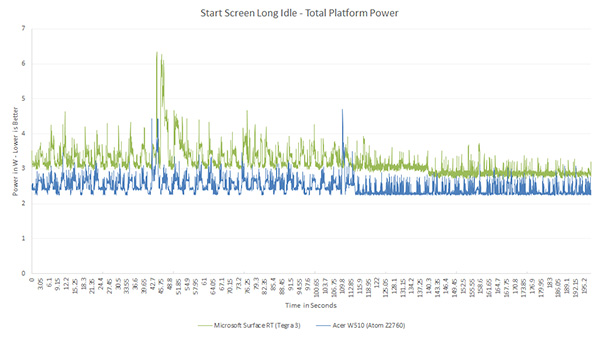
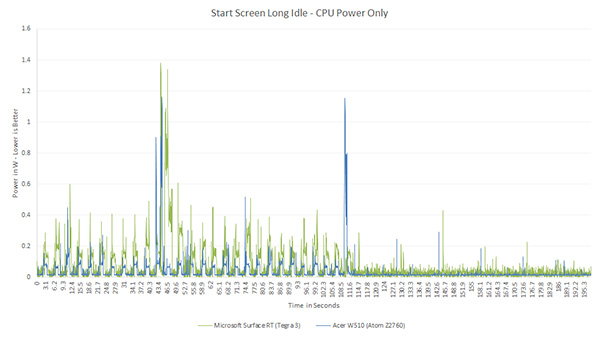
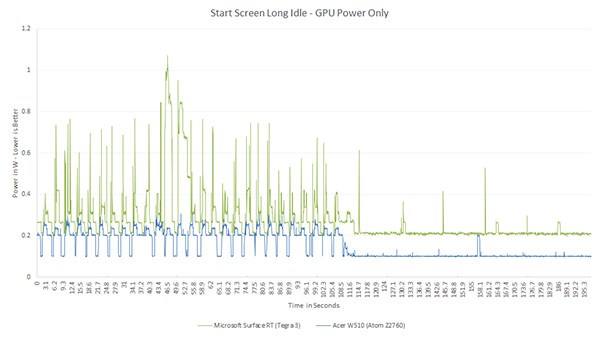

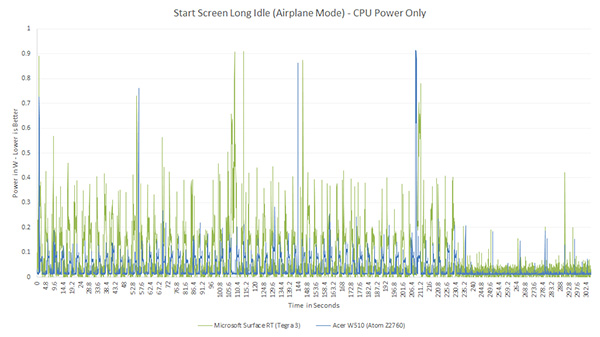
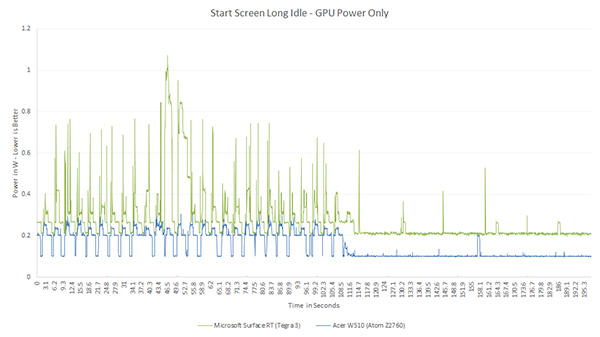








163 Comments
View All Comments
teiglin - Monday, December 24, 2012 - link
You don't have to wait for the coming years for Intel vs. ARM to replace Intel vs. AMD. The latter stopped being interesting when Bulldozer fell so short of Sandy Bridge. I was a long-time AMD fan, but they haven't released a chip I'd consider buying for myself since Deneb.kyuu - Tuesday, December 25, 2012 - link
I have to disagree. I'm far more interested in what AMD is going to bring to the x86 tablet space with Hondo than what Intel's doing, ATM.aspartame - Monday, December 24, 2012 - link
Intel cannot compete with ARM despite having the most advanced fabrication technology. Surely the new atom is somewhat more power efficient than the old Tegra 3, but it costs 3 times more.KitsuneKnight - Monday, December 24, 2012 - link
The 'new' Atom is also just a tweaked 5 year old Atom. What will be interesting is seeing how the next generation of Atoms compare against ARM's latest and greatest. Intel has proven that they can go blow for blow with ARM SoCs, despite just a couple years ago people claiming that x86 would never even be within several watts of any ARM.yyrkoon - Tuesday, December 25, 2012 - link
Technically speaking, Intel still can not approach ARM in power usage. It is all in the definition of "ARM". So, it is a matter of context.I think more appropriately people were saying that atom could never hope to approach ARM in the embedded market. Where they would be completely right. Unless you think an Atom based SoC could run under 100mw under full load.
Again . . .context.
KitsuneKnight - Tuesday, December 25, 2012 - link
People were talking about the Smartphone and Tablet spaces, not the ultra-tiny processors embedded into devices like SSDs. Intel doesn't really seem to want to compete in that space with their CPUs, as there's no profit to be made and no threat to their core business (they do occasionally compete with other products, but those aren't core products).The 'context' most people were talking about is the context that Intel is actually shown to be competitive in (at the very least against last gen devices). We'll see if they can appropriately pull the rest of their ecosystem together to lower the power consumption of the rest of the system, along with further reducing the power consumption of Atom while upping the performance.
yyrkoon - Tuesday, December 25, 2012 - link
This discussion started years ago in the embedded space where it should have stayed. Where ARM is still truly RISC in natureHowever, no less than a year ago( and probably more like 2 years ago ), several ARM low power desktop systems were demonstrated to use only 1-2w power consumption under full load. On YouTube no less. While Intel ( with atom ) was still fumbling around above 10w.
Having said that. "Competitive" is still a subjective term in this case.
At some point one has to realize, <this company> has <this> advantage over <another company>. But at what cost ? Which is partly why partners of ARM still exist in this market space.
jjj - Monday, December 24, 2012 - link
Funny how you compare 2 chips running 2 different OSes and you deem the results conclusive. How low can you go?karasaj - Monday, December 24, 2012 - link
Except if anything Windows RT will draw less power than Windows 8.Also, if you hook a resistor/volt meter etc. up to the CPU itself, the OS isn't going to do much.
Reikon - Monday, December 24, 2012 - link
Windows 8 and RT are essentially the same OS for different instruction sets with a few arbitrary feature differences unrelated to performance.